Читать книгу Statistics and Probability with Applications for Engineers and Scientists Using MINITAB, R and JMP - Bhisham C. Gupta, Irwin Guttman - Страница 94
2.7.3 Interquartile Range (IQR)
ОглавлениеOften we are more interested in finding information about the middle 50% of a population. A measure of dispersion relative to the middle 50% of the population or sample data is known as the IQR. This range is obtained by trimming 25% of the values from the bottom and 25% of the values from the top. This is equivalent to finding the spread between the first quartile and the third quartile, which is IQR and is defined as
(2.7.3)
Example 2.7.2 (Engineers' salaries) Find the IQR for the salary data in Example 2.7.1:
Salaries: 48, 51, 51, 52, 54, 55, 58, 62, 63, 69, 72, 73, 76, 85, 95
Solution: In order to find the IQR, we need to find the quartiles and or equivalently 25th percentile and the 75th percentile. We can easily see that the ranks of 25th and 75th percentile are given by (see (2.7.1))
Consulting Step 3 of Example 2.7.1, we find that (52 has rank 4) and (73 has rank 12). Thus, the middle 50% of the engineers earn between $52,000 and $73,000. The IQR in this example is given by
Notes:
1 The IQR gives an estimate of the range of the middle 50% of the population.
2 The IQR is potentially a more meaningful measure of dispersion than the range as it is not affected by the extreme values that may be present in the data. By trimming 25% of the data from the bottom and 25% from the top, we eliminate the extreme values that may be present in the data set. Thus, the IQR is often used as a measure of comparison between two or more data sets on similar studies.
